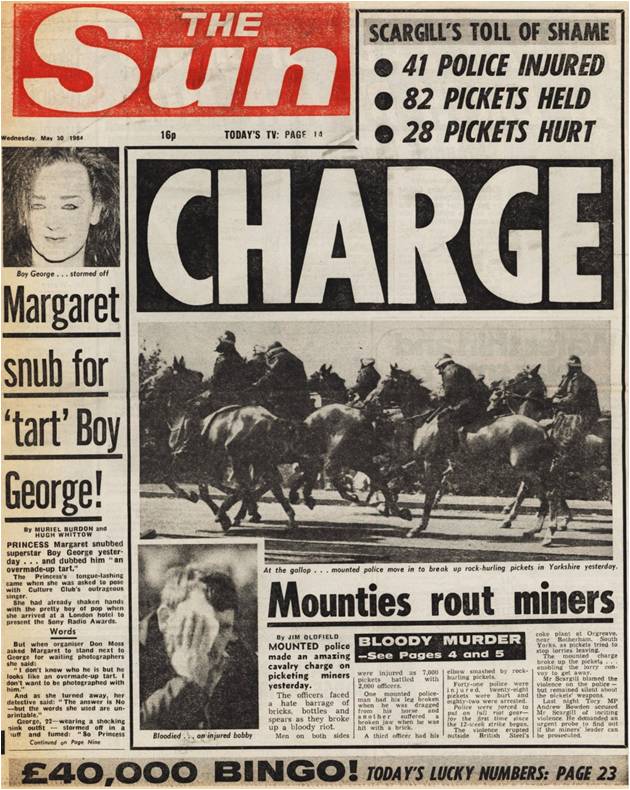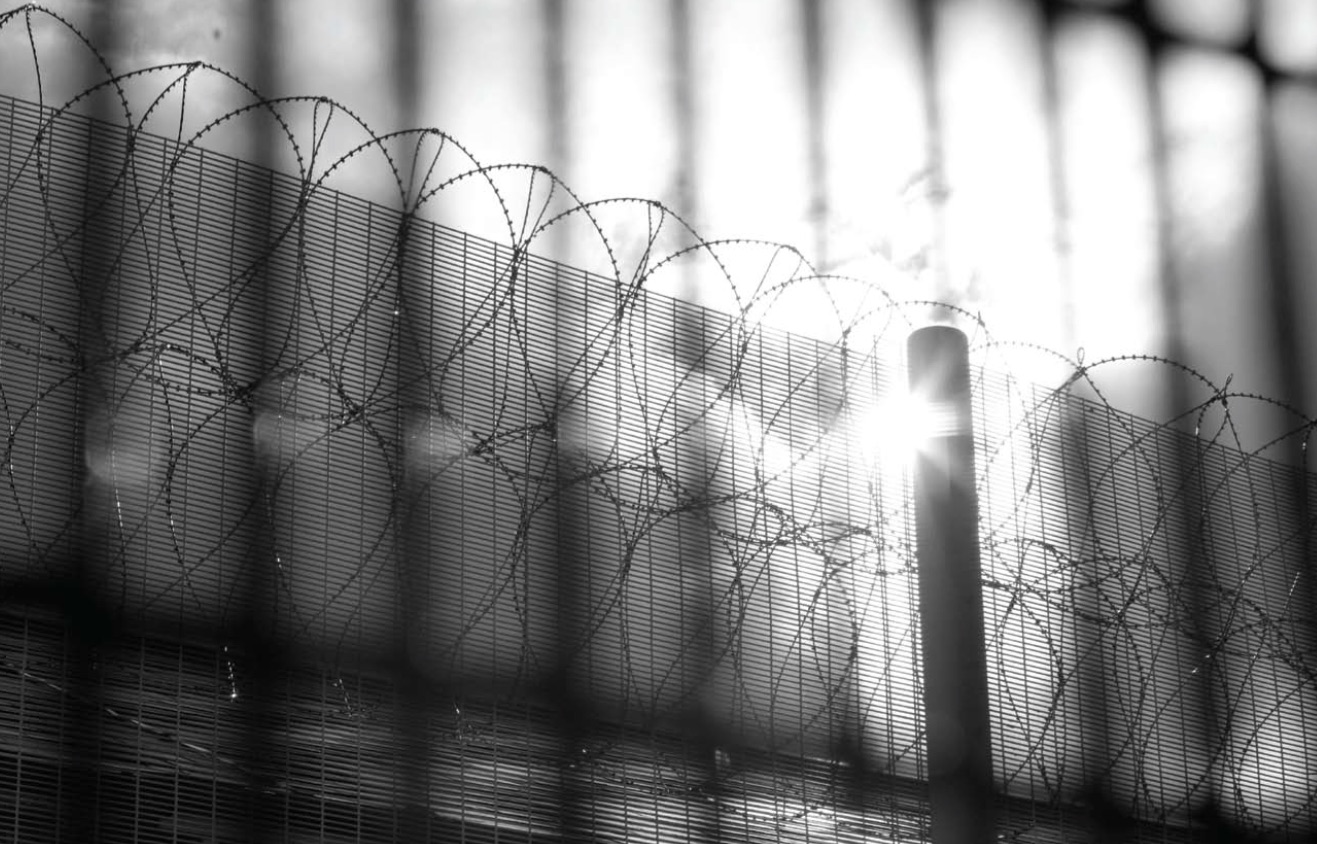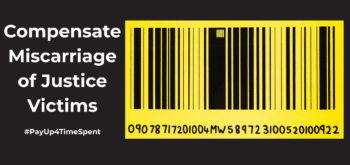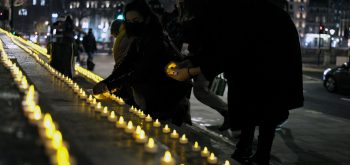[contextly_auto_sidebar]

Pic by Martin Shakeshaft, from his Strike84 collection
Since The Hillsborough Independent Panel (HIP) reported at the end of 2012 there has been a reinvigorated campaign to open a public inquiry into what happened at ‘The Battle of Orgreave’ on June 18 1984.
In many people’s minds, the events themselves and the alleged establishment cover-ups which followed are part of the same story.
- You can read Mark George QC, who represented 22 of the Hillsborough families, on Orgreave (When the South Yorkshire Police were out of control; and ‘Like Hillsborough, Orgreave cries out for justice’)
- Earlier this week Sarah Champion, Labour MP for Rotheram wrote for Labour List in support of the Orgreave Truth and Justice Campaign for an inquiry. So far 70 MPs have written to the home secretary calling for an inquiry.
Men who were young at Orgreave are now approaching their 60s. Memories fade, evidence disappears and many who were there have not lived to see the truth come out. But this is not history, it is a vivid and open wound. Its impact lives on, both for the community, but in particular for those who were there. We owe it to them to deliver the truth and allow these wounds, finally, to heal
Both Orgreave and later Hillsborough happened in the policing area covered by South Yorkshire Police. Both incidents were followed by police accounts which attempted to foist blame onto the civilian parties. Both involved police on the opposite side from groups of working class individuals who were then demonised in the media and by the police force themselves. There have been suggestions, and later evidence, of police collusion when drafting statements and of unusual statement making techniques which have thrown doubt on the police version of events in both cases.
The miners’ strike started in March 1984, backed by 80% of miners at its highest point and ended almost a year later. The dispute had been violent at times resulting in the death of two miners at separate plants. A few days before the June 18 clash, 80 miners had been arrested at Orgreave, including NUM leader Arthur Scargill, and 62 injured. On the day, the police had deployed 6,000 officers including van loads of Public Support Unit (PSU) officers, mounted officers with dog teams and long and short riot shields.
Teaching the miners a lesson
From evidence given by officers at the later criminal trials (full transcripts on the Orgreave Truth and Justice Campaign website here), it is now clear that the police attempted to excuse their aggressive policing by describing a barrage of missiles thrown by the miners followed by violent attacks. There were accusations that the police tactics that day were engineered to encourage a violence from the pickets thus ensuring that a ‘battle’ ensued.
As Michael Mansfield QC observed at the 1985 criminal trial: ‘They wanted to teach the miners a lesson – a big lesson such that they wouldn’t come out in force again.’ The police argued that this was not true, that they had arrived that day believing that violence was likely, due to their previous experiences and due to the behaviour of the NUM leading up to that day; they said they had simply responded to increased violence from the miners with increased force.
Following an alleged missile attack from the miners the police were deployed on a series of charges of short and long shield officers in riot gear, mounted officers and ordinary foot officers with their batons drawn. The charges pushed the miners into a residential area, there were many arrests and many injured miners. Arthur Scargill was seriously injured. The clashes were caught on film and shown on the news around the country. The result of the violence on the day was damage to property in the nearby village, many injured miners and injured police officers.
Ninety five miners were charged with offences including riot, unlawful assembly and violent disorder. The trial of the first 15 began on May 8 1985 and ended a few weeks later with the acquittal of all 95. The police case fell apart. The way in which the police had attempted to manipulate evidence to support their case shocked many as did the revelations regarding the police tactics used against the miners and the injuries which resulted.
Police evidence during the trial revealed that miners were arrested for offences such as threatening behaviour and then later charged with much more serious offences such as unlawful assembly and riot upon detention. Officers admitted to having had chunks of their statements dictated to them by CID Detectives in a room at the onsite command centre. Others had to admit to having written substantially the same statement as other officers in their section. The transcripts of the trial clearly show that the police officers often did not know their own stories. Officers contradicted their own accounts during cross-examination as well as the accounts of others who had been involved in the same arrests, charges and units. There is little surprise that the charges against the miners did not stick. When the IPCC later considered the evidence connected to Orgreave they revealed that: SYP accepted that excessive force had been used by officers on the day; that senior officers exaggerated the violence used by the miners; that some officers committed perjury relating to the civil claims and that all of this was then covered up by the force.
Following the collapse of the criminal trial no disciplinary action was ever taken against any of the officers involved. Civil claims were brought against the force for actions including wrongful arrest, malicious prosecution and assault. In 1991 the force paid out £425,000 in an out of court settlement to 39 of the miners, as a result the evidence against SYP was never properly interrogated.
Hillsborough
On 15th April 1989 Liverpool fans were involved in a crush at the Leppings Lane end of Sheffield Wednesday Football Club’s ground as they attended the semi-final match against Nottingham Forest. Crushing had developed from before 2:30pm outside the turnstiles on Leppings Lane. Police in the area did not manage the crowd, cordons – which had been used successfully in previous years – were not employed and the fans were actively encouraged to congregate in the outer concourse, described by Inspector Sykes at the recent inquests as a known ‘bottleneck’. With a complete lack of action from the Match Command team in the police control box Chief Inspector Marshall called for the Exit Gates to be opened. Match Commander David Duckenfield gave the order to open the gates, Gate C was opened and hundreds and hundreds of fans were allowed to enter the Leppings Lane Terraces eight minutes before kick-off. With inadequate signage and a complete lack of a direction from police and stewards fans spilled down the tunnel beneath the West Stand and into the already crowded central pens, 3 and 4.
Officers pitch-side and in the control box looked on as the crushing at the turnstiles was transferred onto the terrace, the lack of intervention would later be explained away as part of their use of the ‘find their own level’ tactic of policing matches. The tactic was useless on a terrace of this nature. It was split into 7 ‘pens’ separated by high metal fences, higher spiked fences around the pitch perimeter and with gates in the radial fences which were so narrow and badly signposted that most fans were unable to move across the terrace when an area became overcrowded without scaling a fence.
Officers’ reactions were slow. Public safety was, by their own admission, the last thing on their minds, and they had been briefed that morning by David Duckenfield, match commander, to only open the safety gates to the terraces in a serious emergency. Their eventual response was too little too late. The ambulance men present at the match also failed to react adequately or in good time. It is now apparent that the slow response of both emergency services contributed to the deaths of the 96 individuals.
Following the events of the day there was no public criminal trial nor was there a civil trial. Compensation was paid to survivors in out of court settlements and, mirroring events after Orgreave, the evidence against the police was kept out of court.
 The Truth
The Truth
The reaction of SYP to both Orgreave and Hillsborough was to blame the civilians involved. After Orgreave the force told exaggerated stories of violent miners who stole helmets and shields from the specially trained PSU officers. Pickets who threw blocks of concrete, milk bottles and fruit with nails stuck into it. After April 15 1989 there were accounts of drunken fans who violently and concertedly pushed against and dove under police horses and gates at the ground, Liverpool fans who attended a match drinking from Party7 cans and carafes of wine.
At Orgreave miners spoke of a relatively calm scene early on in the day which only became dangerous when the mounted officers charged into the pickets. A Sheffield Police Watch photographer and observer described the scene as appearing as if the police had a plan; he arrived to find around 600 miners relaxing on the field surrounded by riot police and mounted officers. Liverpool fans arriving at Hillsborough described a happy festival atmosphere, many had had the usual drink or so prior to the match but there was no real trouble and the very small number of arrests that day seems to support their claims. In both cases the audio visual (AV) evidence clearly showed the police narrative to be false.
Evidence has shown that the briefing against fans came directly from Peter Wright, the Chief Constable of SYP at the time of both Orgreave and Hillsborough. The police narrative took hold immediately after both events and gained support from both the media and the government. Thatcher’s press minister Bernard Ingram MP was briefed by CC Wright following Hillsborough and as a result described the fans and survivors as a ‘tanked up mob’.
 They were accused of urinating on the dead and of impeding rescue attempts in the now infamous article by the Sun tabloid, in an article entitled ‘The Truth’, who maintain that they got their story directly from senior police officers at SYP. Despite the Taylor Inquiry completely exonerating the fans and laying much of the blame at the door of SYP the ‘official’ version of events was vigorously promoted, including during the Popper Inquests. The narrative was created in a fertile environment where football fans were thought of as hooligans and working class men from Liverpool had a bad reputation following the Toxteth riots in 1981 and the Heysel Stadium disaster of 1985.
They were accused of urinating on the dead and of impeding rescue attempts in the now infamous article by the Sun tabloid, in an article entitled ‘The Truth’, who maintain that they got their story directly from senior police officers at SYP. Despite the Taylor Inquiry completely exonerating the fans and laying much of the blame at the door of SYP the ‘official’ version of events was vigorously promoted, including during the Popper Inquests. The narrative was created in a fertile environment where football fans were thought of as hooligans and working class men from Liverpool had a bad reputation following the Toxteth riots in 1981 and the Heysel Stadium disaster of 1985.
For similar reasons police accounts regarding the miners’ conduct were accepted by the public at a time when the Prime Minister herself had described the miners as ‘the enemy within.’ Having been briefed by SYP, Margaret Thatcher supported the police line that the miners were violent first, she described them as ‘mob rule.’
The Sun again played an important role; the headline on June 19 1985 was ‘Charge’, the story which followed described an ‘amazing cavalry charge on striking pickets.’ And told how the ‘officers faced a hate barrage of bricks, bottles and spears as they broke up a bloody riot’. The similarities are fairly stark when laid side by side.
On both occasions officers have said they were told not to complete their police notebooks. The way in which statements were taken on both occasions was described as out of the ordinary. Officers from Orgreave described, during evidence at trial, arresting pickets and taking them back to the Command Centre to be processed. They were sent to an upper room where they were told they would write their statements.
They waited for the room to fill with other officers as well as a few CID officers who then dictated parts of their statements to them which they wrote down word for word. Officers discussed their evidence as they drafted their statements and the result was, in more than one instance, two or more officers with carbon copy statements. This was explained away by CC Wright and other senior officers as being a result of officers being tired on the day after hours on duty in chaotic circumstances.
The IPCC recently revealed that there was an internal review in 1986 of the evidence gathering after Orgreave, it found that ‘a policy decision was taken by the senior officer to dictate to a group of arresting officers’ the ‘scene setting’ opening paragraphs of their statements. During the Hillsborough Inquests it was revealed that this review was written by SYP officer Walter Jackson, who was present at the ground during the Hillsborough disaster and is one of the officers whose conduct is currently being investigated by the IPCC. One of the officers named in evidence by an Orgreave officer as being in the room whilst statements were dictated was Chief Inspector Sumner an officer who was also present at Hillsborough and recently reacted to the inquests Unlawful Killing verdict by saying it was wrong. Sumner stated that ‘the Liverpool fans weren’t completely innocent.’
After Hillsborough many officers were told not to write in their note books. Some officers were brought into lecture theatres at police HQ and told to write statements. Accounts were written on plain paper which did not bear the statement of truth. This meant that, when the amendments of officers accounts was unearthed, SYP could explain that the accounts that they amended were simply first drafts not sworn statements and the evidence which was amended and removed was opinion and speculation. The amendment of the statements could not be properly considered at the recent inquests as it was decided to be outside the scope; however some officers, including Debra Martin, gave evidence of being out under immense pressure to change their statements by senior officers at the time.
Peter Metcalf was the force solicitor at the time of both incidents and, it was revealed during evidence, was involved in amending the officers’ statements after Hillsborough. He was also the solicitor charged with settling the miners’ claims. The Hillsborough cover-up is now being investigated by the IPCC who have said they will be ready to hand over their files to the CPS at the end of 2016. They then anticipate the CPS will take 3-6 months to decide on what if any charges should be brought.
 There has been an inquiry, a private prosecution and two major inquests into what happened at Hillsborough, there are still ongoing investigations by the police, under Operation Resolve, into police actions on the day and by the IPCC into any possible cover-up, perjury and misconduct in public office. They will hand their files to the Crown Prosecution Service (CPS) who aim to announce any charges in the middle of 2017.
There has been an inquiry, a private prosecution and two major inquests into what happened at Hillsborough, there are still ongoing investigations by the police, under Operation Resolve, into police actions on the day and by the IPCC into any possible cover-up, perjury and misconduct in public office. They will hand their files to the Crown Prosecution Service (CPS) who aim to announce any charges in the middle of 2017.
In contrast there has never been a public inquiry into what happened at Orgreave despite campaigns and calls for accountability over the years. The only look at the events of the day occurred during the discredited criminal trials which were held to prosecute miners and not to interrogate police behaviour.
Following a complaint regarding the policing of Orgreave by SYP at the end of 2012- shortly after the HIP report – the IPCC looked into the possibility of opening up a public inquiry into the policing of Orgreave and the subsequent prosecutions. In June 2015 the IPCC announced they would not be going ahead. The reasons given were that: the passage of time meant that the allegations of assault or misconduct could not be pursued; some of the matters had been subject to complaints and civil proceedings at the time and detailed analysis of the evidence had not revealed issues regarding individual officers which could now be investigated.
The Hillsborough Inquests found that all public and private bodies involved in the planning, policing, health and safety and emergency response had been to blame for the disaster, that the 96 victims had been unlawfully killed and that the fans had not contributed to the disaster.
The inquests came after the issue had been, in the then Labour government’s eyes, put to bed by the supposed investigation in 1997 led by Lord Stuart-Smith. His scrutiny took a cursory look at the evidence of policing on the day and the possible cover up following the disaster and found that there was no basis for a public inquiry, nothing to add to the findings of the Taylor Inquiry and the Popper Inquests. These findings were in accordance with the privately expressed views of Home Secretary Jack Straw and Prime Minister Blair. It seems the scrutiny was ordered simply to fulfil a manifesto pledge and keep the families happy despite the government’s belief that there was nothing more to learn about the disaster and its aftermath. It would be unfortunate if the same were to happen with the IPCC’s investigation into Orgreave.
Following the outcome of the Hillsborough inquest, it is clear that, however difficult it may be, evidence can still be analysed, statements can still be given and new witnesses and evidence can still be found even so long after the event. It is also clear that simply because civil and misconduct proceedings occurred in the past this by no means suggests that the investigations and outcomes at the time were correct or that there is no more evidence to find.
With regards to Hillsborough there was clearly scope to find out more even after two inquests, the Taylor Inquiry, the Stuart Smith Scrutiny, civil proceedings and a private prosecution.
The Chief Constable of SYP was suspended following the Hillsborough Inquest’s verdict, having presided over a force which presented a case in an adversarial way, which again attempted to re-run the slurs against the fans and which did not approach the proceedings with an attitude of openness and honesty. There was some difficulty in finding a suitable replacement however the current CC Dave Jones has started well, he has accepted the verdict of the Inquests and promised to cooperate with the ongoing investigations. Importantly Jones has also said he would ‘welcome an appropriate independent assessment of Orgreave.’ SYP still has a long way to go in winning back public trust and support; it faces calls for the force to be disbanded but Jones’ comments are a positive start.
We have recently heard that the inquests into the Birmingham bombings will be reopened, closure on Hillsborough is on the horizon, and then there is the long awaited release of the Chilcott report. In this period of seeming transparency and learning from past mistakes, it cannot be that evidence regarding this travesty of justice is allowed to remain undisclosed.
We have heard that a lack of resources is part of the decision not to go ahead with the full inquiry. Theresa May has appeared to show commitment to uncovering historical police transgressions and cover-ups. She must properly fund a full inquiry into Orgreave so that the similarities with Hillsborough don’t simply end with a cover up without the successful decades-long battles for truth, justice and accountability.





